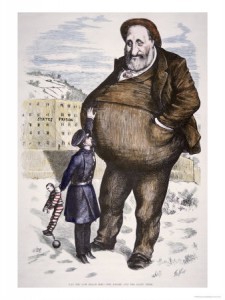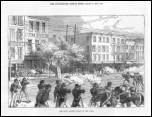April 26

“Spring comes early in the Gulf States, and April 26 has been made Confederate Memorial Day by Alabama, Mississippi, Florida, and Georgia.
“North and South Carolina have selected May 10.
“In Tennessee, the second Friday in May has been made Confederate Day.
“Virginia keeps Confederate Memorial Day on May 30.
“So that as the spring advances, there are several observances of memorial day, beginning with the lower South, and following on, in the later spring, of States to the North, until Virginia and at the national capital both sides honor their departed heroes upon the same day.”
Confederate Memorial Day remembers the Confederate soldiers of the American Civil War, and is the predecessor of the national Memorial Day holiday. It’s observed on different dates throughout the South. In some states it’s a statutory holiday; it others it’s a holiday by proclamation.
Georgia law, for example, obliges the governor to proclaim a holiday on either January 19, April 26, or June 3 (Confederate Memorial Day in Georgia). Meanwhile, Mississippi observes Confederate-related holidays on the Mondays closest to all three of those dates.
Why January 19, April 26, and June 3?
January 19: the birthday of Confederate General Robert E. Lee. From 1983 to 2000, Virginia combined Lee’s birthday and General “Stonewall” Jackson’s birthday with, ironically enough, the national holiday of Martin Luther King Jr. Birthday (January 15) to form Lee-Jackson-King Day.)
June 3: the birthday of Confederate President Jefferson Davis.
April 26: the anniversary of the single largest surrender of Confederate troops in 1865…General Johnson’s surrender to General Sherman at Durham Station, North Carolina.
The End of the Civil War
Johnson’s surrender on April 26 was neither the first nor the last surrender of the Civil War.
General Lee had already surrendered at Appomattox Court House, Virginia, on April 9, 1865.
Jefferson Davis, meanwhile, wasn’t captured until May 10. (Also the anniversary of the 1863 death of “Stonewall” Jackson.
And technically, the last surrender wasn’t until November 6, when the crew of the CSS Shenandoah (who didn’t receive word of the war’s end until August) arrived in Liverpool, England. (They didn’t want to surrender to the Yanks.)
But General Johnson’s surrender entailed the Army of Tennessee as well as all active forces in Georgia, Florida, and the Carolinas. Nearly 90,000 soldiers in all.
+ + +
The impetus for Confederate Memorial Day, and Memorial Day in general, came from Ladies Memorial Associations, which grew out of women’s groups that supported the troops and cared for the wounded during the war.
According to the Encyclopedia of the American Civil War:
“The first LMAs assumed the grisly task of overseeing the reinterment of Southern soldiers from mass graves to individual graves in newly designated Confederate cemeteries… These same same women originated Confederate Memorial Day, an annual observance held each spring that paid homage to the soldiers who had died for the Southern cause.”
By 1865, it had become a tradition to decorate the graves of the fallen soldiers with flowers.
As early as 1867 a song entitled Kneel Where Our Loves are Sleeping” was dedicated to “The Ladies of the South Who are Decorating the Graves of the Confederate Dead.”
Kneel where our loves are sleeping
They lost but still were good and true
Our fathers, brothers fell still fighting
We weep, ’tis all that we can do
Several towns claims to have held the first Decoration Day ceremonies, on or around the first anniversary of Johnson’s surrender, including two towns named Columbus.
In Columbus, Mississippi, a group of women who were decorating the graves of Confederate soldiers also stopped to place flowers on the neglected graves of Union soldiers. The event made national news.
In Columbus, Georgia, meanwhile…
“The ladies are now and have been for several days engaged in the sad, but pleasant duty of ornamenting and improving that portion of the City Cemetery sacred to the memory of our gallant Confederate dead, but we feel it is an unfinished work unless a day be set apart annually for its especial attention…
“Therefore, we beg the assistance of the press and the ladies throughout the South to aid us in the efforts to set apart a certain day to be observed, from the Potomac to the Rio Grande, and be handed down through time as a religious custom of the South, to wreathe the graves of our martyred dead with flowers; and we propose the 26th day of April as the day…
“…the veriest radical that ever traced his genealogy back to the deck of the Mayflower, could not refuse us the simple privilege of paying honor to those who died defending the life, honor and happiness of the Southern Women.”
To this day, in accordance with Georgia law stated above, Georgian state workers get this day off, although not all are of one mind. Writes one blogger:
“Who knew the honor of Southern women was at stake during the Civil War?
“As a black woman, I don’t really subscribe to celebrating the Confederacy in any way, shape, or form. So I thought about showing up for work in protest, but then… I decided instead that I am going to celebrate my FREEDOM and reflect on my ancestors who endured the Middle Passage, slavery, and the Civil Rights Movement.”
Either way, the song rings true.
Here we find our noble dead
Their spirits soar’d to him above
Rest they now about his throne
For God is mercy, God is love
Then let us pray that we may live
As pure and good as they have been
That dying we may ask of Him
To ope the gate and let us in— “Kneel Where Our Loves are Sleeping”, 1867
Origin of Confederate Decoration Day – from the files of Alan Doyle









